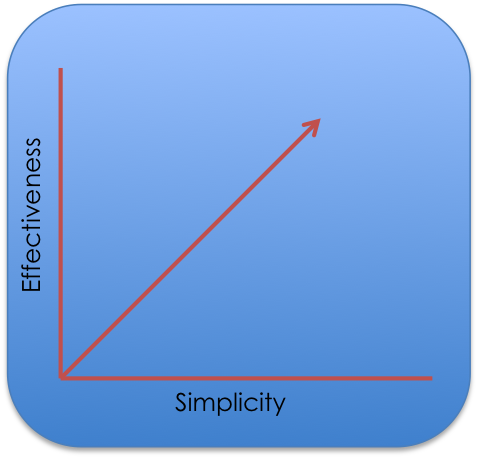Not long after becoming a manager of organization development for a large healthcare system, the OD team and I decided we needed to develop a written statement that succinctly expresses our commitment to keeping things simple. We were going to post this statement boldly as a reminder that although healthcare is incredibly complex, we were committed to simplifying things where and when we could. So we did. We decided to start preparing for this new way of thinking by all reading “Insanely Simple: The obsession that drives Apple’s success“. The idea was for us to develop wildly impactful interventions that operational teams and leaders could use easily and deliver them in an insanely simple format. The iPhone is a crazy complex piece of technology but it’s interface was designed to be intuitive and simple to use.
For those wondering, we settled on: Clear. Concise. Simple.
Understanding healthcare finance is about as complicated a thing as a leader has to decipher…but instead of learning the many theorists and academic nature of finance, how about helping leaders translating that data into information. I’ve encountered some incredibly intelligent and strategic finance leaders, but rare is the one who has such a command of the data that they can translate it into operational information. My friend Dave is one of them and I can honestly say that I looked forward to and enjoyed hearing him deliver his financial reports.
As a leader, we are live in a world of complexity. For example, department scorecards have a litany of metrics – all very important mind you. I’ve seen scorecard metrics exceed 40+. Every month, leaders go through a ritual of gathering data from multiple sources to populate a scorecard and report it monthly to the hospital executives. This process forces leaders to remain vigilant of the team’s performance. Most leaders share that scorecard with their team because it’s important for them to be aware of the end result of their work. Month after month managers go over a few of the areas that didn’t quite meet the target and a few areas where they can celebrate successes…and with intentional work, a lot of celebrations. My teams have all been amazing. One of my past team’s employee engagement scores topped the 93rd percentile and our patient experience scores are consistently in the top decile. I could go on and on about my teams, but you’d get bored of hearing all the accolades.
I followed this routine consistently for almost three years before attending a Studer Group conference. Sure I’d heard of them and read a couple of their books, but had never met the legend himself or heard him spread his wisdom in person. Forgive me if you aren’t a Studer fan, I understand, but I am and I’ll share why. And no, I’m not some paid promoter – although for the right amount of money I could be! Quint Studer’s processes are time tested, developed through experience as an operations leader, and if you execute accordingly – you get results. Basically, it works.
I came back and actually integrated some of what I had learned into practice. Not in a, “Hey I went to this conference so the flavor of this month is hardwiring excellence”, but in a strategic, methodical, team-inclusive way. I started with cascaded leader accountability…sure my leaders knew their roles, but we lacked true alignment. This new work included a single-page (read: simple and clear) matrix of goals and individualized weights – not all leaders had direct accountability for every goal, along with 90-day action plans, and individual scorecards. These are to be reviewed monthly at our now-consistent leader meetings. There were other things on the agenda, but that’s a large chunk. Now you may be saying, but Gary, that doesn’t sound revolutionary…and you’re right. But it’s a foundational component to clarifying and simplifying focus. My leaders went from trying to manage to the entire scorecard to just a handful of true Key Performance Indicators. How “key” can something be if there are 40 other “key” indicators?

We also changed the way we presented the scorecard to the team. We created a single document listing only the goals/metrics on the leader accountability matrix, categorized them by priority and color-coded them in the traditional red-yellow-green. Simple. Clear. In one glance, you could get a snapshot of our performance. Does that mean everything else is unimportant? Of course not, but those other 30+ metrics on the full scorecard were put on maintenance mode. How did that work? Honestly, the adjustment period was longer than I had hoped. I am cheap and being a good steward of resources, I designed my own templates in Excel – sure it lacked some of the functionality of fancy software – I ran a surgery center, not Apple – but it got the job done. There was definitely a learning curve for using the templates. There was a learning curve as we learned how to prioritize using this new matrix. There was a new process of reviewing processes at monthly leadership meetings in a structured way. So we started that journey and I was relentless. My leaders were resilient and agile so we made good progress. It was not “hardwired” right away but we got there. Making things simple isn’t easy…in fact, many would say it’s harder than creating the original “thing” but it’s necessary for leaders. Our teams are busy and bombarded with a lot of “stuff”. Let’s help them stay out of the weeds.
The Challenge
Take a few minutes to look at your processes, reports, activities. Are there ways to translate data into information in ways that are clear and easy to understand? How can you help create focus and accountability without adding complexity?
If you’re interested in reading the tool-packed book from Studer, it’s called, “A Culture of High Performance: Achieving Higher Quality at a Lower Cost.“


